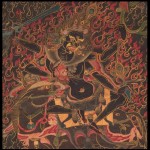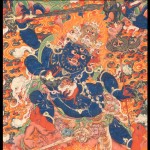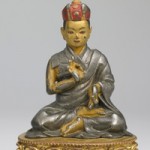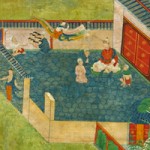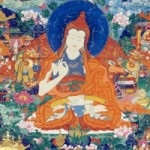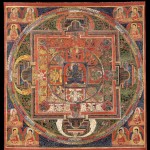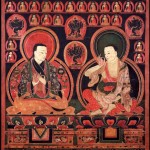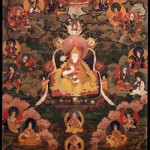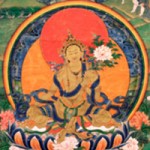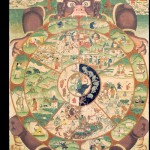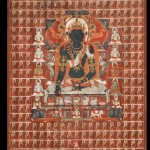This drawing was not meant to be hung on the wall as a work of art, but once folded, and possibly placed in an amulet, it was intended solely for veneration. This work has captions in red identifying each figure, making it a “rosetta stone” for identifying these figures in other paintings of this school. Continue reading
Palden Lhamo Dusolma
This wonderful Bhutanese painting combines a black
background with a small portion of blue-green landscape at the bottom of the canvas, creating the sense that one is looking beyond the coastal rocks onto an ocean of blood under a black sky. Continue reading
Explore Composition and Structure
This crowded, vibrant painting is dedicated to nine wrathful deities and centers on the six-armed form of Mahakala, the principal protector of the Gelug School of
Tibetan Buddhism. Continue reading
Explore the Wheel of Existence
The wheel of existence is a representation of Buddhist beliefs about the cycle of life, death, and rebirth known as samsara. The energy produced by one’s past actions (karma) is the force that traps beings within this cyclic existence. Continue reading
Explore The Stories Of Objects
Every object on view in the museum has a story about where it has come from and how it has been exhibited. Click one of the four objects from the Casting the Divine exhibition to learn its story. Continue reading
Explore Teaching Narratives
Many Buddhist stories are morality tales that teach about Buddhist notions, such as karma and the merit accumulated from good and bad actions, from the perspective of many life times.
Continue reading
Explore Historical Narratives
Historical narratives in Himalayan painting are often presented by displaying multiple episodes from a figure’s life around a large central image of that figure. The central figure of this painting is the Indian guru Shantarakshita. Stories of his life are depicted around him like panels of a comic strip, and each episode is divided by either landscape or architectural elements. Continue reading
Explore the Mandala of Guhyasamaja
In the Buddhist traditions mandalas represent the realm of a deity. The word “mandala” means center and periphery. They can be painted on cloth or as large wall murals; fashioned from metal,wood, or stone; or created with color threads or sand. Continue reading
Explore Lineage Paintings
In Tibetan Buddhism the specific lineage of teachers of each school is carefully documented through sets of paintings. The lineage always begins with a divine figure and then shows Indian teachers followed by Tibetan teachers in chronological order. Continue reading
Previous Incarnations of the Dalai Lamas
In this thangka the Seventh Dalai Lama is shown surrounded by some of his previous incarnations. According to the expanded list partially represented by this painting, there are more than fifty previous incarnations of the Dalai Lama, including early emanations of Avalokiteshvara. Continue reading
Four Mandalas of the Vajravali Cycle
This exquisite thangka is the thirteenth painting in a set depicting the mandalas of the Vajravali cycle. It features four mandalas and numerous figures between them belonging to two deity assemblies that, although not described in the Vajravali text, relate to the top two mandalas. Continue reading
